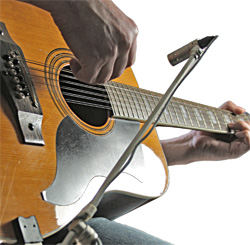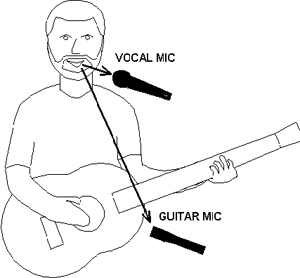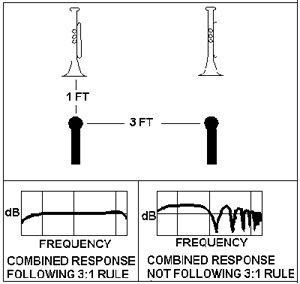Suppose you’re reinforcing a singer/guitarist in mono, with one microphone on the singer and another mic on the acoustic guitar.
The vocal sounds funny – sort of hollow or filtered. What’s happening?
Both microphones are picking up the singer, with the mic for the guitar about one foot farther from the singer’s voice than the mic for the vocals (Figure 1, below).
So there are two vocal signals in the mix – one is direct and the other is delayed.
When a signal is combined with its delayed replica at equal levels, certain frequencies cancel out, depending on the length of the delay.
In the frequency response of the combined sounds, “notches” occur at frequencies where the sounds cancel out each other.
This is called a comb filter effect, because the frequency response looks like the teeth of an inverted comb.
In general, if two mics pick up the same sound source at different distances, and their signals are fed to the same channel, it might cause phase cancellations.
These are dips or notches in the frequency response caused by sound waves at certain frequencies combining out of phase.
The result is a colored, filtered tone quality.
3 To 1 Rule
To reduce phase cancellations between two mics, follow the 3 to 1 rule: The distance between mics should be at least three times the mic-to-source distance (Figure 2).
For example, if two mics are each 4 inches from their sound sources, the mics should be at least 12 inches apart to prevent phase cancellations.
How was the 3:1 rule determined? When you add a signal to its delayed replica at equal levels, you get severe comb filtering with deep notches.
But when you mix direct and delayed signals at different levels, you get less deep notches.
Specifically, if the delayed signal is 9 dB less than the direct signal, the comb-filter notches are only +/- 1 dB, so for all practical purposes, they are inaudible.
How do we make sure that the delayed signal, picked up by a distant mic, is at least 9 dB below the direct signal picked up by the closer mic?
Put the distant mic at least three times farther from the source than the close mic is. Due to the inverse square law, the level drops 9.54 dB when the distance to the source is increased three times.
So the 3:1 rule insures that the level at the distant mic will be down at least 9 dB, so the mixed signals will have comb filtering of +/- 1 dB or less.
A ratio of 4:1 or more is even better. The 3:1 ratio is the minimum to avoid audible comb-filter effects.






















